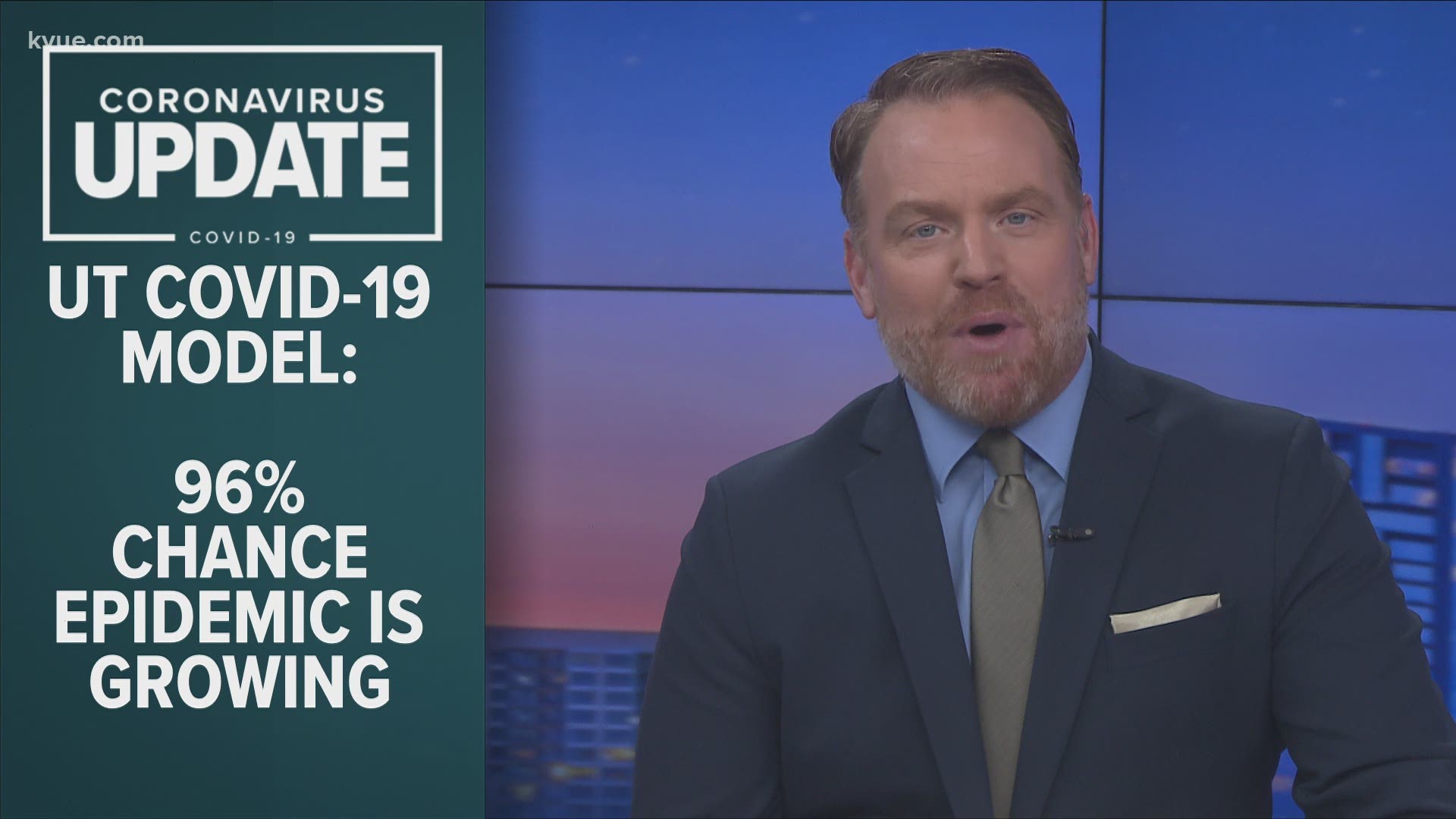AUSTIN, Texas — Editor's note: The video published above is from Oct. 20, when the UT model data said at the time there was a 96% chance the epidemic was growing.
In the Oct. 27 Travis County Commissioners meeting, Dr. Mark Escott told the commissioners that University of Texas COVID-19 Modeling Consortium data had increased to 100% chance "the epidemic is growing."
In the Oct. 20 meeting, Escott had told the commissioners the UT model data had risen from a 66% chance "the epidemic is growing" to "almost 90%." KVUE checked the UT model the morning of Oct. 20, and the UT model had increased to a 96% chance.
"As I mentioned last week, this is not a forecast," Escott told the county commissioners on Oct. 20. "This is the best guess at what the future looks like if the transmission stays the same. So, what does this mean? This means we have to reduce transmissions."
In Austin Pubic Health's COVID-19 media Q&A on Oct.14, Dr. Mark Escott mentioned the University of Texas COVID-19 Modeling Consortium data as one factor in the reasoning for his recommendation to Travis County Judge Sam Biscoe to opt out of Gov. Greg Abbott's bar reopening. Dr. Escott said that morning the UT COVID-19 model suggested that there was a 66% chance "the epidemic is growing."
WATCH: Dr. Escott updates Travis County commissioners on UT Model stats (fast forward to nearly two hours into the meeting)
RELATED:
"Following my review of the governor's executive order No. 32, as well as the guidelines for bars and similar establishments, and reviewing our COVID-19 data, I made the recommendation to Judge Biscoe that bars remained closed at this stage and at least for the next 14 days," Dr. Escott said. "This was based on a concerning trend we've seen over the past week in terms of our hospital beds being utilized, ICU beds and ventilators, as well as the projections from UT's Modeling Consortium, which indicates a 66% chance of increasing epidemic over the next month. This would put us at significant increases in admissions to the hospital, hospital beds being utilized and ICU beds being utilized by Nov. 1."
WATCH: Austin, Texas coronavirus update: Health officials speak amid bars reopening around the State
This statistic, along with other measures, such as increases in hospitalized individuals, ICU bed utilization and ventilator use all contributed to Dr. Escott's recommendation to Judge Biscoe, he said.
Biscoe heeded Dr. Escott's recommendation and opted Travis County out of Abbott's bar reopening order.
"Based on the memo from Dr. Mark Escott, COVID-19 continues to be a threat to Travis County," Biscoe said in a statement on Wednesday. "In the past 10 days, Travis County has seen an increase in hospitalized individuals, ICU bed utilization and ventilator use. As such, I cannot in good conscience allow bars to reopen at 50% of capacity at this time. The risk to our public health is too great, especially now that students of all ages have returned to the classroom. As we move forward, I will continue to work with Dr. Escott to reevaluate data collected, and in 14 days will determine if Travis County is in a position to safely reopen bars. Until then, I encourage everyone to continue practicing safety measures that will help us reduce the transmission of COVID-19."
On Oct. 14, UT's COVID-19 Modeling Consortium also showed 8% more infections in the "14-day change" category in the Austin area. By Oct. 20, it had increased to 64%. By Oct. 27, it had increased to 110%. When looking at the Texas projections on Oct. 14, the Modeling Consortium said there was 18% more infections in the "14-day change" category. As of Oct. 20, the Texas projections had increased to 39%. By Oct. 27, the Texas projections had increased to 47%.
"The Austin data you are looking at is estimating there are 8% more currently infectious people today in the Austin-Round Rock metro area compared to 14 days ago," a UT spokesperson told KVUE on Oct. 14. "Confirmed cases represent only the number of people who took a test and tested positive. Infections represent the estimate for how many people have the virus and are contagious at a point in time."
PEOPLE ARE ALSO READING:

